

Around 1950, a number of neurosurgeons around the world started to work with a new method to destroy brain areas thought to be involved in controlling extreme forms of pathological behavior, such as destructiveness.
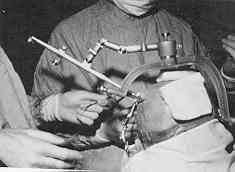
Instead of resorting to extensive surgical destruction of internal brain structures, such as in lobotomy and leucotomy, they used a new method which was used previously only for treating Parkinson's disease, focal epilepsy and brain tumors: stereotactic neurosurgery.
With this method, the neurosurgeon needs only to make a small opening in the patient's skull, under local anesthesia. Then, a thin straight probe is introduced into the brain, and using a remarkably precise system of geometrical coordinates, it is targeted onto the internal structure of the brain which the neurosurgeon wants to remove. In this way, quantities of nervous tissue as small as a few cubic millimeters, totally inside the brain, can be lesioned without destroying other parts of the brain over it. Brain tissue at the tip of the electrode can then be destroyed by passing an direct electrical current through the electrode. Other variations of the technique involves thermolesioning (by increasing or decreasing temperature, using a radiofrequency probe or a cannual full of near-freezing alcohol), Implanting radioactive pellets inside the brain (a method called brachytherapy) has also been used.
The pioneering work in stereotactic neurosurgery in humans, was performed at Temple University Hospital, in Philadelphia, USA, by Drs. Ernst Spiegel and Henry Wycis, in 1947. They developed the first stereotactic apparatus to be used in humans, which is now displayed at the Smithsonian Institution in Washington. Although the stereotactical method was developed in 1902 by British neurosurgeon Sir Victor Horsley and his associate Dr. Clark, it was intended for animal experimentation, only. Although his group developed later a stereotactic frame for humans, it seems that it was never used for an actual surgery.
Among other surgeries, Spiegel pioneered pallidotomy in 1949, a stereotactic ablation of a part of the brain called pallidum, which becomes altered in Parkinson's disease, a degenerative disease accompanied by uncontrollable tremor, muscle rigidity and dificulty to move. He also performed a few psychosurgeries.
After Spiegel, a number of other centers in the USA, Canada, Europe and Japan started to perform stereotactic surgeries. One of the early pioneers was Dr. Lars Leksell, from the Karolinska Institute, in Stockholm, Sweden; who developed his own stereotactic frame, which is used until today. As a result, many kinds of new operations were developed to target specific brain structures such as the amygdala, thalamus, hypothalamus, and cingulum which are believed to be associated with emotional responses to various stimuli. Many centers around the world reported striking results with this technique, particularly with patients with uncontrolable assaultive or suicidal behavior.
In 1965, Dr. Narabayashi and his group in Japan, reported on patients who were operated for the treatment of incontrolable violent behavior. He used the stereotactic technique to make small lesions in a part of the brain named amygdaloid bodies, or amygdala. Of 27 patients (including 19 epileptics), 14 showed dramatic improvement and 9 were significantly improved; meaning that assaultive violent behavior was entirely eliminated, without affecting other mental abilities. Soon afterwards, glowing reports started to pour out of neurosurgical facilities around the world: India, Mexico, France, Denmark and United States. Not only the amygdalae, but also other structures involved in the control of violent behavior were operated upon: ventromedial hypothalamus, thalamus, limbic cortex, and others.
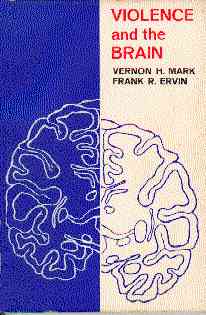
In 1970, two physicians from Harvard Medical School Dept. Neurosurgery, Dr. Vernon H. Mark, a neurosurgeon, and Dr. Frank R. Ervin, a psychiatrist, published a book which was an instant sensation, not only among the specialists.
Titled "Violence and the Brain", the
book related in detail the experience of the two doctors in treating incontrolably violent neuropsychiatric patients,
by using an entirely new approach to psychosurgery. Instead of performing "blind" lesions in the brain
of violent patient, Drs. Mark and Ervin sought a method to determine with precision the location of the diseased
brain tissue which was responsible for the behavioral discontrol syndrome. They worked with patients for whom the
most likely cause of episodic violent behavior was a hyperactive focus in the limbic, or "emotional"
brain. Before using the stereotactical technique to perform the surgery, they implanted thin metallic electrodes
into the brain of the patient, and tested for telltale signs of abnormal electrical activity which accompanied
abnormal behavior.
Let's take one of the examples of their book. Julia, one of her patients, was often victim of violent bursts of incontrollable rage, when she would throw objects or pound against the wall, many times hurting herself or others. In between the episodes she was a nice and agreeable young lady.
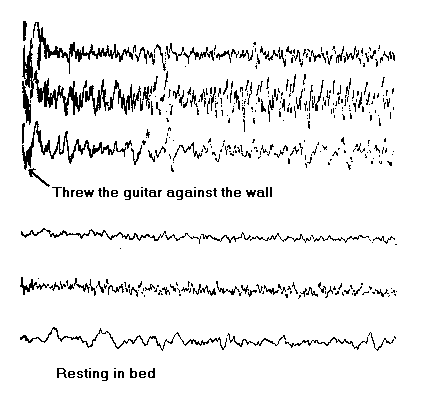
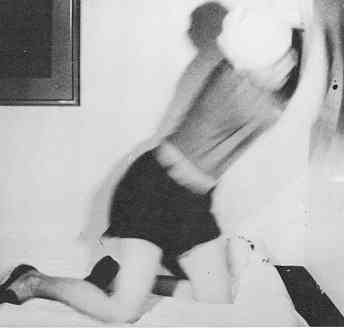
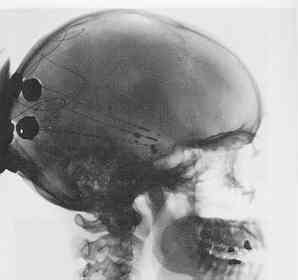 She received the intracerebral electrodes, and was monitored
from a distance. Her brain activity showed characteristic abnormal activity during the episodes of aggressive behavior.
She received the intracerebral electrodes, and was monitored
from a distance. Her brain activity showed characteristic abnormal activity during the episodes of aggressive behavior.
Passing a small electrical current at the tip of the electrode, the faulty brain area was removed. After the surgery, Julia became free of the behavior discontrol episodes, while maintaining intact their intellectual capabilities and normal emotional profile.
A new era in neuropsychosurgery, how it was called, seemed to begin.
Unfortunately, it didn't develop into what Drs. Mark and Ervin expected. The times had changed, and the decade of the 70s, when their findings were published, there was a ugly mood of the public opinion against anything remotely resembling psychosurgery, due to the excesses and free abandon of the physicians during the lobotomy era. The book was lambasted by many groups and in the media, and the surgery for violence was interrupted. A long stigma was to brand psychosurgery for many years to come...
However, neuropsychosurgery, or neurosurgery for
treating mental diseases, as it is called today, continues to be practiced, particularly after non-invasive methods
for destroying localized spots in the brain, using radiosurgery, were developed. See the next section for a report on how is psychosurgery today.
Picture Credits:
Mark, V.H. and Ervin, F.R.. "Violence and the Brain", Harper & Row, New York, 1970.
 To
Know More
To
Know More
| From: The History of Psychosurgery Author: Renato M.E. Sabbatini, PhD Source: Brain & Mind Magazine, June 1997 |